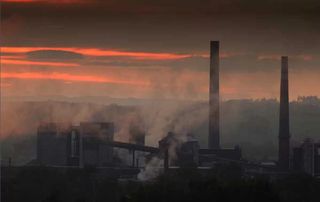Earth Could Blow Past a Dangerous Temperature Threshold in Less Than a Decade

The average temperature on Earth is in danger of exceeding a major climate threshold inside a decade, say researchers in Australia, if a dormant source of warming in the Pacific Ocean switches on, giving a boost to global temperature rise.
Under the 2015 Paris Agreement on climate change, governments around the world committed to keeping global warming to "well below" 2 degrees Celsius compared to pre-industrial levels and to pursue efforts to limit temperature increase to 1.5 degrees Celsius.
But, according to a new analysis in the journal Geophysical Research Letters by Ben Henley and Andrew King of the University of Melbourne, the 1.5 degrees Celsius target may be reached or exceeded as early as 2026 if the Interdecadal Pacific Oscillation (IPO) shifts sea surface temperatures in the Pacific from a cool to a warm phase.
The IPO fluctuates in much the same way as El Niño and La Niña in the Pacific, but it occurs between every 10 to 30 years rather than roughly every two to seven. The study's authors write that, similar to El Niño and La Niña translating to "the boy" and "the girl," the IPO's phases are called El Tio and La Tia – "the cranky uncle" and "the kind auntie."
RELATED: Oceans Could Take a Million Years to Recover From Steep Drops in Oxygen Levels
The planet experienced a positive IPO, or El Tio, in the periods 1925-1946 and 1977-1998, both of which were periods that saw "rapid" increases in global average temperatures, according to the study. The reverse — a prolonged negative phase, or La Tia — occurred from 1947-1976, when global temperature rise "stalled." A Tia formation has been present since 1999, and Henley and King suggest that this may have been responsible for temperatures rising less than some scientists had expected.
A recent study in the journal Nature points to evidence of a return of El Tio, which Henley and King say could lead to a return of significant, average temperature increase around the world.
Get the Space.com Newsletter
Breaking space news, the latest updates on rocket launches, skywatching events and more!
Using computer models, Henley and King ran a range of scenarios. But under no model variation was the outlook comforting.
"Even if the IPO remains in a negative phase, our research shows we will still likely see global temperatures break through the 1.5 degrees Celsius guardrail by 2031," Henley said in a statement. "If the world is to have any hope of meeting the Paris target, governments will need to pursue policies that not only reduce emissions but remove carbon from the atmosphere."
RELATED: Montana's Iconic Glaciers Could Disappear by 2030
The study assumes that countries will continue emitting carbon dioxide under a business as usual scenario. That pessimism has garnered some pushback from other researchers, who point out that a number of nations are taking steps to meet their Paris commitments.
Over the last few years, growth in greenhouse gas emissions has flatlined. And, at a meeting in Bonn last week, countries reaffirmed their commitment to Paris targets and began writing a "rule book" for achieving them. However, diplomats and scientists have long expressed concern that even meeting the agreed targets might not be enough to prevent temperatures climbing by 1.5 degrees Celsius. And there is a risk that President Donald Trump might withdraw the United States — responsible for 15 percent of annual global greenhouse gas emissions — from the agreement.
"Policy makers should be aware of just how quickly we are approaching 1.5 degrees Celsius," Henley said. "The task of reducing emissions is very urgent indeed."
Originally published on Seeker.
Join our Space Forums to keep talking space on the latest missions, night sky and more! And if you have a news tip, correction or comment, let us know at: community@space.com.
